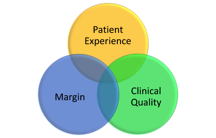A Venn Approach to Excellence in the Dental Office
Gregory P. Heintschel, DDS, MBA | April 29, 2016

“Continuous improvement” and “patient-centered care” are terms tied to the pursuit of excellence in the dental industry. But what do these terms mean and how do you achieve excellence in these categories? The dental office’s operations need to be broken down into their most basic parts: clinical competency, patient satisfaction, and margin (profitability). By attaining balance between these three components, clinicians can enhance every sector of their practice and achieve unprecedented success.
Introduced in 1880 to show “the logical relations between a finite collection of different sets,”1 the Venn diagram provides a framework that can define and balance the components of excellence. With this approach, clinicians can identify aspects of their practice that require attention, monitor ongoing operations, and yield predictable outcomes.
Venn has often been compared to a form of “zen.” The implication is when we achieve Venn we achieve a sense of peace, harmony, and enlightenment. The figure below illustrates the Venn diagram and the relationship between the three most vital components in a dental practice.
According to the Venn principle, overemphasizing one component can be detrimental to the others; for example, emphasizing profitability over the care of patients is likely to have a negative impact on standard of care and patient satisfaction. As your understanding of the Venn model improves, it can be used to determine culture, policies, and processes, and help to minimize surprises and negate unintended consequences in your practice.
Standard of Care
In evaluating clinical competency and paying heed to high standards of care, one can hope that his/her patients’ health will improve over time, and that there will be fewer incidents in their treatment. With the improved health of their patients, the dental team can focus on more complex rehabilitation, cosmetic enhancements, and other advanced procedures. Remaining costs shift from treatment to prevention. On a larger scale, as individual health is improved, the health of the communities in which we live and work will also improve.
A Different View
When patients speak of excellence, they have an entirely different perspective than that of the healthcare giver. By understanding and accommodating the patient’s experience of your office and the care they receive, patients are more likely to abide by office policies, such as keeping appointments, paying bills (on time), and accepting treatment. Patients are also more likely to take responsibility for their oral health and maintain the dental care received. Finally, patients who feel satisfied have fewer complaints and increased loyalty. And when patients are satisfied—it’s contagious; employees feel more appreciative and appreciated by patients, they become more engaged and more fulfilled in their work.
The Margins
The value of profitability cannot be underestimated. Not only can it provide a better life for our families, but it can also open opportunities to invest in a technological edge and elevate the level of care you offer patients. With higher margins, a greater level of mission can be incorporated. With improved financial results we can increase our ability to provide care for those without the financial ability to do so. We can also finance trips to dental education courses and training, and incorporate vital products into our practice.
The Venn approach creates an office “zen” that enhances workflow, improves quality of care, and bolsters employee and patient satisfaction. By using this concept in your office, you will enhance your practice’s profitability and improve your practice’s offerings. For more information about the Venn approach and how to transform your practice, visit the My Community Dental Centers’ website at http://www.midental.org.
About the Author
Gregory P. Heintschel, DDS, MBA, currently serves as the president and chief executive officer of My Community Dental Centers, a non-profit dental service organization. Dr. Heintschel has consulted, lectured, and written extensively on issues related to continuous quality improvement in a patient-centered environment.
References
1. Venn Diagram. Wikipedia website. https://en.wikipedia.org/wiki/Venn_diagram. Accessed April 29th, 2016.




